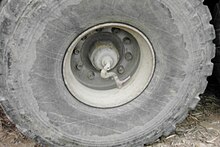
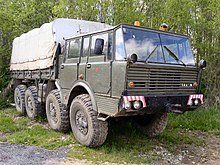
This article needs additional citations for verification .(October 2020) |
A central tire inflation system (CTIS) is a system to provide control over the air pressure in each of a vehicle's tires as a way to improve performance on different surfaces.


This article needs additional citations for verification .(October 2020) |
A central tire inflation system (CTIS) is a system to provide control over the air pressure in each of a vehicle's tires as a way to improve performance on different surfaces.
Lowering the air pressure in a tire creates a larger contact patch between the tire and the ground, and makes driving on softer ground much easier. It also does less damage to the tire surface. This is important on work sites and in agricultural fields; by giving the driver direct control over the air pressure in each tire, maneuverability is greatly improved. Softer tires also cushion against rough terrain and road damage, such as washboarding, more effectively. Reducing tire pressure also reduces the extent to which the tires grind against loose surfaces, significantly reducing dust and silt.
Another function of CTIS is to maintain tire pressure if there is a slow leak or puncture. In this case, the system controls inflation automatically based on the selected pressure the driver has set. [1]
CTIS also extends truck, tire, and drive train life, by significantly reducing vibration and shock loading. Feedback from Australian logging contractors show a doubling of transmission and differential life.[ citation needed ]
The technology is extensively used in many off-road transport operations. In many countries, especially Australia, New Zealand and South Africa, CTIS is used in logging, mining, and power line maintenance, as it significantly reduces environmental impact when transporting logs, or travelling on gravel or dirt roads.
From 1984, General Motors offered CTIS for the Chevrolet Blazer and various pickups. AM General also offered CTIS for the civilian Hummer H1 vehicle.
There have been attempts at employing central tire inflation systems on aircraft landing wheels (notably on the Soviet Antonov An-22 military transport) to improve their preparedness for unpaved runways.
CTIS was first used in production on the American DUKW amphibious truck, which was introduced in 1942.
The Czech Tatra T813's central inflation and deflation system was designed to maintain pressure even after multiple bullet punctures. Military-spec Tatra trucks are equipped with CTIS as standard.
Several trucks used by the U.S. military, such as the HMMWV, HEMTT, and FMTV, are equipped with CTIS. The feature is also common in Soviet and Russian military trucks.

A semi-trailer truck is the combination of a tractor unit and one or more semi-trailers to carry freight. A semi-trailer attaches to the tractor with a type of hitch called a fifth wheel.

An anti-lock braking system (ABS) is a safety anti-skid braking system used on aircraft and on land vehicles, such as cars, motorcycles, trucks, and buses. ABS operates by preventing the wheels from locking up during braking, thereby maintaining tractive contact with the road surface and allowing the driver to maintain more control over the vehicle.

A tire is a ring-shaped component that surrounds a wheel's rim to transfer a vehicle's load from the axle through the wheel to the ground and to provide traction on the surface over which the wheel travels. Most tires, such as those for automobiles and bicycles, are pneumatically inflated structures, providing a flexible cushion that absorbs shock as the tire rolls over rough features on the surface. Tires provide a footprint, called a contact patch, designed to match the vehicle's weight and the bearing on the surface that it rolls over by exerting a pressure that will avoid deforming the surface.

An off-road vehicle (ORV) also referred to as an off-highway vehicle (OHV), overland vehicle, or adventure vehicle, is any vehicle designed to drive on non-paved roads and surfaces, such as trails and forest roads, that have rough, uneven, and low-traction surfaces. Off-road vehicles have been popularized through competitive off-road events, such as the annual Dakar Rally, which challenges drivers to navigate a variety of terrain across various countries.
Automobile handling and vehicle handling are descriptions of the way a wheeled vehicle responds and reacts to the inputs of a driver, as well as how it moves along a track or road. It is commonly judged by how a vehicle performs particularly during cornering, acceleration, and braking as well as on the vehicle's directional stability when moving in steady state condition.
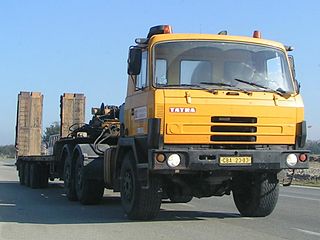
The Tatra 815 is a truck family, produced by Czech company Tatra. It uses the traditional Tatra concept of rigid backbone tube and swinging half-axles giving independent suspension. The vehicles are available in 4x4, 6x6, 8x8, 10x8, 10x10, 12x8 and 12x12 variants. There are both air-cooled and liquid-cooled engines available with power ranging from 230–440 kilowatts (310–590 hp). As a successor to Tatra 813 it was originally designed for extreme off-road conditions, while nowadays there are also variants designated for mixed use. The gross weight is up to 35,500 kg (78,264 lb).

Aquaplaning or hydroplaning by the tires of a road vehicle, aircraft or other wheeled vehicle occurs when a layer of water builds between the wheels of the vehicle and the road surface, leading to a loss of traction that prevents the vehicle from responding to control inputs. If it occurs to all wheels simultaneously, the vehicle becomes, in effect, an uncontrolled sled. Aquaplaning is a different phenomenon from when water on the surface of the roadway merely acts as a lubricant. Traction is diminished on wet pavement even when aquaplaning is not occurring.
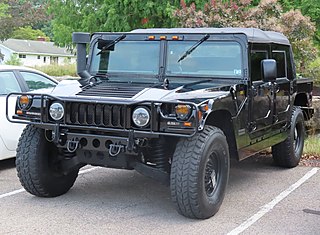
The Hummer H1 is a full-size four-wheel-drive utility vehicle based on the M998 Humvee, which was developed by AM General when it was a subsidiary of American Motors Corporation (AMC). Originally designed strictly for military use, the off-road vehicle was released to the civilian market.

The tread of a tire or track refers to the rubber on its circumference that makes contact with the road or the ground. As tires are used, the tread is worn off, limiting its effectiveness in providing traction. A worn tire can often be retreaded.
Traction, traction force or tractive force is a force used to generate motion between a body and a tangential surface, through the use of either dry friction or shear force. It has important applications in vehicles, as in tractive effort.
A run-flat tire is a pneumatic vehicle tire designed to resist the effects of deflation when punctured, allowing the vehicle to continue to be driven at reduced speeds for limited distances. First developed by tire manufacturer Michelin in the 1930s, run-flat tires were introduced to the public market in the 1980s. They have increased in popularity over time.
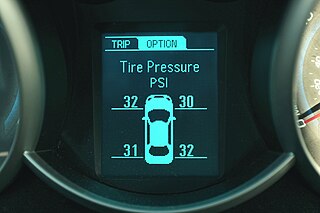
A tire-pressure monitoring system (TPMS) monitors the air pressure inside the pneumatic tires on vehicles. A TPMS reports real-time tire-pressure information to the driver, using either a gauge, a pictogram display, or a simple low-pressure warning light. TPMS can be divided into two different types – direct (dTPMS) and indirect (iTPMS).

The M939 is a 5-ton 6×6 U.S. military heavy truck. The basic cargo versions were designed to transport a 10,000 pounds (4,500 kg) cargo load over all terrain in all weather. Designed in the late 1970s to replace the M39 and M809 series of trucks, it has been in service ever since. The M939 evolved into its own family of cargo trucks, dump trucks, semi-tractors, vans, wreckers, and bare chassis/cabs for specialty bodies. 44,590 in all were produced.

A flat tire is a deflated pneumatic tire, which can cause the rim of the wheel to ride on the tire tread or the ground potentially resulting in loss of control of the vehicle or irreparable damage to the tire. The most common cause of a flat tire is the puncturing of the tire by a sharp object, such as a nail or pin, letting the air escape. Depending on the size of the blowout, the tire may deflate slowly or rapidly.

The TatraT813 was a truck produced in Czechoslovakia by the Tatra company. It was produced from 1967 to 1982. The basic representative of this series was a military version of the 8×8 Kolos (Colossus), which was able to pull trailers up to a total weight of 100 tons. Tatra also produced a civilian version in either 6×6 or 4×4. After fifteen years of production, 11,751 vehicles were built in all modifications. Many units were exported to the USSR, East Germany, Romania and India.

A spare tire is an additional tire carried in a motor vehicle as a replacement for one that goes flat, has a blowout, or has another emergency. Spare tire is generally a misnomer, as almost all vehicles actually carry an entire wheel with a tire mounted on it as a spare rather than just a tire, as fitting a tire to a wheel would require a motorist to carry additional, specialized equipment. However, some spare tires are not meant to be driven long distances. Space-savers have a maximum speed of around 50 mph (80 km/h).

Inspection and maintenance of tires is about inspecting for wear and damage on tires so that adjustments or measures can be made to take better care of the tires so that they last longer, or to detect or predict if repairs or replacement of the tires becomes necessary. Tire maintenance for motor vehicles is based on several factors. The chief reason for tire replacement is friction from moving contact with road surfaces, causing the tread on the outer perimeter of tires to eventually wear away. When the tread depth becomes too shallow, like for example below 3.2 mm, the tire is worn out and should be replaced. The same rims can usually be used throughout the lifetime of the car. Other problems encountered in tire maintenance include:

A bicycle tire is a tire that fits on the wheel of a bicycle or similar vehicle. These tires may also be used on tricycles, wheelchairs, and handcycles, frequently for racing. Bicycle tires provide an important source of suspension, generate the lateral forces necessary for balancing and turning, and generate the longitudinal forces necessary for propulsion and braking. Although the use of a pneumatic tire greatly reduces rolling resistance compared to the use of a rigid wheel or solid tire, the tires are still typically the second largest source, after wind resistance, of power consumption on a level road. The modern detachable pneumatic bicycle tire contributed to the popularity and eventual dominance of the safety bicycle.

A logging truck or timber lorry is a large truck used to carry logs. Some have integrated flatbeds, some are discrete tractor units, and some are configured to spread a load between the tractor unit and a dollied trailer pulled behind it. Often more than one trailer is attached.

The Tata LPTA is a military truck family developed and produced by Indian manufacturer Tata Advanced Systems. The trucks are available in 4×4, 6×6, 8×8, 10×10 and 12×12 configurations. With extreme off-road capabilities, they are proposed as a replacement for the Czech-designed Tatra trucks currently used by Indian Armed Forces.